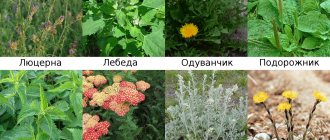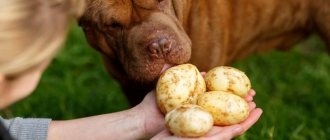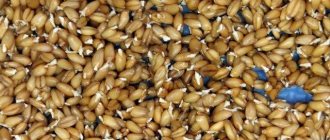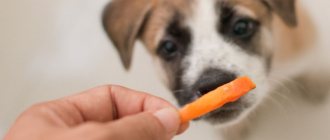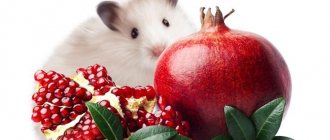Parsley in a hamster's diet
If these greens are so beneficial for humans, then can they be added to a hamster’s food?
Parsley is an important component of a nutritious animal's nutrition. It prevents the occurrence of vitamin deficiency in your pet. Therefore, it is recommended to include it in the rodent’s diet, but not more than once or twice a week.
Greens must be free from treatment with harmful chemicals, pesticides and growth accelerators. Before your pet eats it, parsley must be washed in running water and dried.
It is also worth considering that parsley affects intestinal function. Therefore, these greens should not be given daily. For pregnant or lactating females, parsley should be temporarily excluded from the diet.
If you freeze your greens yourself for the winter, you can use them too. To do this, frozen parsley must be doused with boiling water and dried before giving it to the hamster.
Can pets eat these greens?
Hamsters (Djungarian, Syrian, Roborovsky, Campbell)
The diet of any hamster should be rich and varied. One of the sources of vitamins is greens. In summer and autumn, an adult rodent should receive up to 300 grams of greens, and 100 grams is enough for young rodents. Parsley is a useful source of vitamins and microelements, which is why it should be included in the diet of hamsters at least twice a week. It can prevent the occurrence of vitamin deficiency. It is important to remember that it affects bowel function, so it does not need to be given every day.
Due to its composition, parsley is of great benefit to rodents.:
- collagen, which is in its composition, improves immunity;
- useful for older animals, as it prevents arthritis;
- ascorbic acid relieves vitamin deficiency;
- as useful as the prevention of colds and diseases of the digestive system;
- Great benefits for pregnant females and during lactation: protects the mother’s body from viruses and infections, makes milk more nutritious.
Greens should be clean and not treated with chemicals, pesticides or growth accelerators. Before giving it to your pet, it should be rinsed under running water and dried. In winter, you can also use frozen parsley. To do this, you must first pour boiling water over it and dry it well.
Guinea pigs
Guinea pigs, like other pets, need vitamins and additional nutrients. Therefore, you can and should add parsley and other greens to your regular diet . It is thanks to her that the animal will receive the vitamin C, phosphorus and potassium it needs. They also need parsley for proper digestion. You can give both the root of the plant and its green part.
An animal can receive no more than 15 mg of greens per day for an adult animal. If this is your first time giving your pig parsley, you should start with a small dose and observe how she reacts to its use. This green is a diuretic and has a toxic effect in large doses. But it is completely contraindicated for pregnant females and during lactation.
Rabbits
Rabbits are only given parsley that they have grown themselves, so that it has not been chemically treated. Rabbits, including decorative ones, love greens very much and are ready to eat them non-stop. However, you should not give too much parsley at a time. It is best to do this no more than twice a week. Before feeding herbs to rabbits, they should be thoroughly washed . There is no need to give fresh greens, they should be slightly dried, because dry ones are better digested. If it is not possible or time to dry the parsley, then you can simply pour boiling water over it.
An adult rabbit is fed parsley 2-3 times a week. Pregnant individuals especially need it, only if the body reacts to it normally. You can feed 1.5 sprigs of parsley at a time. You should start feeding with parsley carefully and in small doses so as not to provoke an upset stomach. If the absorption process went well and did not cause undesirable reactions, then the dose can be increased at the request of the animal.
Our website contains a lot of interesting materials, for example, about the medicinal properties of parsley, varieties, including curly, seeds, storage in winter, for example, frozen, as well as differences from celery and cilantro.
For dogs
Dogs are considered omnivores, but their digestive systems are not designed to digest greens. This is why many dog owners argue about the topic: can a dog be given parsley?
Parsley contains many vitamins and minerals:
- phosphorus;
- folic acid;
- sulfur;
- potassium;
- calcium;
- manganese and others.
All these elements are necessary for the dog's body. That is why parsley can still be added to a dog’s diet. It is completely contraindicated for pregnant and lactating bitches, as well as for those animals that have kidney problems.
It is worth remembering that you should only give fresh, just picked greens, because only they contain all these useful elements. Also, do not forget about the dosage. Dogs should only be given one teaspoon of finely chopped parsley per day.
Parrots (including budgerigars)
As for parsley in the diet of parrots, it should never be given to them.
This is because it contains essential oils and other chemical compounds that are toxic to these birds. Its content in the parrot's body can lead to gastritis, intestinal inflammation, fatty liver and kidney disease.
Chickens
But chickens will benefit from it only after 5-7 days of life. To do this, it is finely chopped and mixed with millet or cereal in proportions of 1:5. In order not to get an undesirable reaction, it must be introduced into the diet gradually. As the chicks grow, increase the amount of greenery. Do not allow it to rot in the feeders. If it is not possible to feed the chickens with fresh herbs, then you can safely use dried, crushed ones.
Cats
Greens are an essential component in a cat’s diet. Moreover, they should receive it every day. Parsley is also included in the list of greens that can be given to them. If your pet does not want to eat it, then you will have to replace it with another one. Don't overuse parsley. It contains essential oils, and in large quantities they can harm the animal. You can give it a little at a time in crushed form, after scalding it with boiling water.
Achatina snails
When fresh, it provides snails with the vitamins and microelements they need to absorb calcium, grow and reproduce. Fresh parsley will immediately attract Achatina with its aroma. Thanks to their numerous teeth, they can easily cope with it. It should be given to snails only fresh, because fresh food stores the substances they need. The most important thing is not to give it in large quantities.
Composition of dill
Like parsley, dill is cultivated in many countries and overlaps with the habitat of hamsters in the wild. Therefore, wild hamsters often eat these greens.
Dill is rich in folic acid and vitamin C. There is some amount of vitamin A, B₃, B₅ and E. There is a lot of calcium and potassium, phosphorus, magnesium and iron.
It helps normalize digestion, speeds up metabolism, and can also be used as a dietary supplement during obesity.
Other greens
If we consider other options for juicy, healthy greens for the Djungarians or Syrians, then the following options are suitable:
- Lettuce leaves are a favorite delicacy for hamsters; before eating, you need to wash the leaves well and renew the stem by cutting just above the end of the stem.
- Spinach will be useful for rodents with constipation; it has a beneficial effect on the digestive system.
But these plants should never be given to a hamster:
- Green onions contain a lot of sugar, which leads to obesity.
- Sorrel – Oxalic acid causes heartburn and bloating. Due to unpleasant sensations in the tummy, the animal may behave aggressively.
- Mint - the menthol contained in its composition irritates the walls of the stomach. May cause ulcers.
- Basil – contains an increased amount of essential oils, which will not benefit the home.
- Mushrooms - in any form are contraindicated for furry rodents; eating them can be fatal.
It’s not possible to pamper your hamster with fresh, juicy greens, but it’s necessary. And make sure it is not spicy. Parsley, dill and lettuce will be an excellent addition to the animal's main food. Such food should be fed three or four times a week, and it should be completely excluded from the diet of pregnant females.
Dill in a hamster's diet
In reasonable quantities, dill can be included in the animal’s diet. Adding these greens to your pet's food daily is not recommended.
Note! Like any other greens, dill easily absorbs harmful substances. Therefore, you need to choose greens that have not been treated with chemicals.
You can also add pre-frozen dill to food, which must be dried after treating it with boiling water.
Important! Dill can have a laxative effect on your hamster, so you should not give it daily.
Are radishes allowed for pets?
Next, we will consider whether radishes can be eaten by various animals.
For dogs
For dogs such as Yorkshire Terriers, it is perfectly acceptable to add small amounts of fresh radishes to their diet periodically. A small portion of finely chopped vegetables is added to food no more than once a week.
The benefits of radishes for dogs are that the coarse, indigestible fibers act as a toothbrush for the mouth and a source of fiber for the gastrointestinal tract.
Radish tops, as a vitamin supplement, are suitable for:
- feeding to puppies;
- lactating bitches;
- young dogs.
Hamsters
This root vegetable is well suited for hamsters of any breed:
- Syrian;
- Dzungarian;
- Roborovsky, etc.
Radishes are rich in vitamins, minerals and fiber, which are very beneficial for animals. The main thing is not to overfeed hamsters with radish - in reasonable quantities it will be beneficial, but in unlimited access it can cause problems with the gastrointestinal tract (bloating, flatulence, abdominal pain).
The root vegetable is cut into small pieces and fed to rodents mixed with other fresh vegetables. It is not recommended to add radishes to your hamster every day. Fresh green tops are good food for rodents , the main thing is not to forget to wash them thoroughly.
Rabbits
Radishes can and should be given to rabbits raised for meat. The root vegetable begins to be gradually added to food from an early age, in crushed form. After three months, rabbits can be fed whole radishes, increasing their content in the diet. The tops of the plant are added to silage and hay, but for this they must be slightly dried.
For decorative rabbits, the root vegetable is also suitable as food. Pets can be fed young peeled radishes. Before feeding rabbits, the tops are added to various green salads.
From the video you will find out whether you can give radishes to rabbits and how to do it:
Guinea pigs
Radishes belong to the cruciferous family. Vegetables from this family are not recommended for guinea pigs. Radish fruits can cause serious intestinal problems in guinea pigs. The root vegetable contains essential oils that irritate the mucous membranes and respiratory tract of rodents. However, the tops of the plant are quite suitable for consumption. The high vitamin C content makes radish tops a healthy treat for your guinea pig.
Results
Can hamsters have parsley and dill? Definitely yes. But, as always, there must be a reasonable approach to feeding animals. The greens must be fresh, it is better to grow them yourself or collect them where there are no nearby roads, or, as a last resort, purchase them in trusted places. Such greens should be added to food once every few days and excluded from the diet of pregnant females.
Did you like the article? Share with friends: [supsystic-social-sharing id=”1"]
- Related Posts
- Can hamsters eat cabbage?
- Can hamsters eat meat?
- What fruits can hamsters eat?
« Previous entry
For Djungarian hamsters
Djungariki are very popular now. These cheerful, active animals also love a variety of tasty food. Djungarian hamsters can be given beets in smaller quantities than usual. It can be different:
- sugar;
- dining room;
- stern
Any variety, including sugar, is quite suitable for ordinary domestic hamsters. For the Djungarian, food or table food is better suited, since high sugar content can cause allergies in the hamster and provoke diabetes. You can give beets to dzhungarikas no more than once every seven days. The treat is no larger than a fingernail. Give boiled and raw beets at an approximate rate of 1 slice raw and 2 slices boiled per month.
Can hamsters eat raw beets?
The debate as to whether beets are allowed for hamsters has been going on for a long time. It is a controversial product, and some owners claim that this vegetable is healthy and necessary for pets to provide the required amount of fluid. Adherents of a different point of view believe that the root vegetable, at best, does not provide any benefit, and at worst, it has a negative effect on the animal’s body.
If you still really want to please your pet and give your Djungarian or Syrian hamster beets, then you can treat them 2-3 times a month, and the slice should not be larger than your thumbnail. Higher frequency may provoke the development of an allergic reaction or cause diarrhea. Small rodents are extremely difficult to tolerate any digestive disorders.
Harm of fried potatoes for a hamster
Potatoes and chips cooked in oil have never been considered healthy for both humans and animals.
- during frying, carcinogens are formed that are toxic;
- contains a large amount of fat, which increases calorie content;
- Usually a lot of salt and seasonings are added, which overload the liver and kidneys.
This product is definitely not recommended for rodents.
Can hamsters have dill?
Fresh dill must be present in the diet of small pets, because this greenery contains many vitamins and nutrients.
But, like any treat, dill should be given to a Djungarian hamster no more than twice a week, as it has a diuretic and laxative effect and can cause diarrhea in the rodent.
- Hamsters are susceptible to colds and even the slightest draft can cause bronchitis. Due to the content of essential oils, dill effectively fights colds and helps improve immunity;
- this green contains fiber, which is beneficial for the rodent’s digestive system;
- dzhungarika dill is necessary if the rodent suffers from obesity, as the plant normalizes metabolism and helps in the fight against excess weight;
- fresh sprigs of dill are simply irreplaceable if your small pet is constipated. This plant acts as a natural laxative and promotes gentle bowel movements and the elimination of toxins;
- Dill is useful for dzungarians as a prophylactic agent that prevents cystitis and kidney diseases, since the greens have a diuretic effect.
Can hamsters eat raw potatoes?
A good owner is always concerned about whether the hamster can eat raw potatoes. There is no need to doubt: the vegetable is useful for a small animal. Potatoes not only contain a large amount of vitamins and minerals, but also allow the rodent to sharpen its teeth. Therefore, potato tubers, pieces of fresh carrots and other hard vegetables should always be in the feeder. If the animal does not have the opportunity to grind its incisors on rough food, then they grow to an unnatural size and deform the jaw. The raw root vegetable is rich in ascorbic acid, which is important for preventing the development of vitamin deficiency. A pet that regularly eats potatoes is cheerful and active and feels good.


